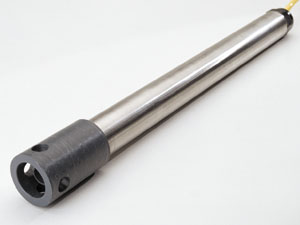WQ600 ORP SENSORS
ORP meters and Oxidation Reduction Potential controllers.

FEATURES:
- Fully encapsulated electronics
- 4-20 mA output
- Marine grade cable with strain relief
- Stainless steel housing
ORP Sensors Product Description
Global Water’s (Redox) ORP sensor is a rugged reliable ORP/Redox measuring device. The ORP sensor is molded to 25 ft of marine grade cable, with lengths up to 500 ft available upon request. The ORP sensor’s output is 4-20 mA with a three wire configuration. The ORP sensor’s electronics are completely encapsulated in marine grade epoxy within a stainless steel housing (online version has 1-¼ inch PVC x 12 inch pipe nipple, threaded both ends with cap)
Global Water’s PC320 ORP Controller to use the ORP sensor’s output to control pumps or alarms. In addition Global Water offers GL500 ORP recorder adds recording capabilities to the WQ600 ORP sensors. The GL500 ORP recorder connects to the ORP sensor’s 4-20mA output to record data.
Measuring ORP
ORP stands for oxidation-reduction potential, which is the measurement (in millivolts, or mV) of the oxidizing or reducing tendency of a solution. Oxidation is the loss of electrons from an atom, molecule, or ion, which may or may not be accompanied by the addition of oxygen. When a substance is oxidized, its oxidation state increases. Reduction is the net gain of electrons. When a substance is reduced, its oxidation state is lowered. Oxidation and reduction reactions always accompany each other. Every oxidation and reduction reaction can be characterized by a halfreaction, which provides all of the chemical substances participating in the reaction (many half-reactions are identified in standard chemistry handbooks or other reference materials). The ORP of the solution depends on the concentrations of the substances participating in the half-reaction. In order to calculate ORP when concentrations vary, you must use the Nernst equation. Due to its logarithmic dependence on concentration and its dependence on multiple solution components, ORP is typically not a good method for measuring concentration. The best use of an ORP is in monitoring and controlling oxidation-reduction reactions. When an oxidation-reduction reaction occurs, there is usually a large change in the ORP, which overwhelms the factors that make concentration measurements an issue. This allows you to ensure that an ORP reaction has gone into completion, and thereby control your application appropriately.
ORP Sensors Specifications
Output: 4-20 mA
Range: -500 to +500mV
Accuracy: 2% of full scale
Maximum Pressure: 40 psi
Operating Voltage: 10-36VDC
Current Draw: 0.2 mA plus sensor output
Warm Up Time: 3 seconds minimum
Operating Temperature: -40 to +131°F (-40 to +55°C)
Size:
Standard: 10-1/2″ L x 1″ Diameter (26.7 cm L x 2.5 cm Dia.)
Online: 15-1/2″ L x 2-1/2″ Diameter (39.4 cm L x 6.3 cm Dia.) (end cap)
Weight:
Standard: 8 oz (227 g)
Online: 22 oz (623 g)
ORP Sensors Options
WQ600 Redox/ORP Sensor (PN# DE0000)
Includes 25 ft of cable.
WQ600-O Online Redox/ORP Sensor (PN# DEA000)
Comes with 1-¼ inch NPT PVC housing.
WQEXC Extra Cable (PN# DH0000)
Standard ORP sensors include 25 ft of cable, but can be purchased with up to 500 ft of cable.
RELATED PRODUCTS
pH 3110 Water proof pH/ORP meter w/case & accessories
ProLab 1000 Bench top pH meter
ProLab 3000 Laboratory pH meter
inoLab® 7110 wastewater pH meter
GL500 ORP/Redox Recorder
ORP/Redox recorder for sensor datalogging. Includes Global Logger Software. With weather proof enclosure and 12V battery.
WQS ORP Sampling System
Does not include ORP sensor.

EZ100 pH Sensor Display
LCD readout display for both portable use and permanent installations.

